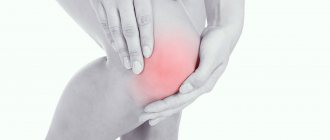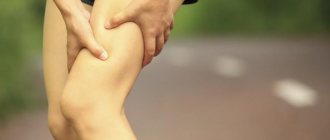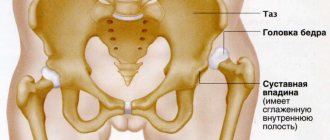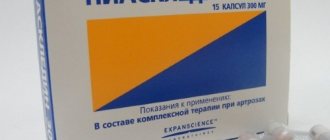Fluid in the knee joint: causes and treatment
Knee diarthrosis is the second, after the hip, in size and importance in the human body. When moving, it takes on the entire weight of the body, therefore it is susceptible to wear, destruction and injury like no other. Traumatologists daily encounter knee problems in patients caused by illnesses and injuries, stress and falls. One of the serious problems is considered to be synovitis - the collection of effusion in the diarthrosis cavity. And if there is additional swelling, pain and swelling, we can say with complete confidence that excess joint fluid has accumulated in it. The special term “synovitis” itself comes from the direct name of the lubricating thicket of the joints – synovium. It is considered a rather dangerous disorder, and in case of it it is better not to postpone a visit to the clinic. It won’t hurt to figure out why synovitis occurs, how to fight it, what measures to take and what it threatens.
Drug therapy
Drug therapy for the accumulation of synovial fluid consists of medications of various groups. The most commonly prescribed drugs are:
- Anti-inflammatory non-steroidal drugs to eliminate inflammation and pain - Diclofenac, Meloxicam, Ketoprofen, Nimesulide.
- Hormonal drugs with anti-inflammatory effects - Hydrocortisone, Prednisolone, Diprospan, Methylprednisolone, Kenalog.
- Broad-spectrum antibiotics for infection of damaged knee tissue - Amikacin, Cefoxime, Vancomycin, Cefriaxon.
- Antihistamines - Suprastin, Tavegil.
- Means for restoring microcirculation of knee tissues - Pentoxifylline, Nicotinic acid.
- Medicines for external use - ointments Indovazin, Indomethacin, Voltaren, Diclofenac.
Additionally, for the septic form of the pathology, medications may be prescribed to lower body temperature - Paracetamol or Ibuprofen.
For chronic accumulation of synovial fluid, protease inhibitors with anti-inflammatory effects are used to prevent degeneration and necrosis of damaged tissue. These include Gordox, Trasylol, Contrical.
Signs that synovial mass is accumulating in the limbs
If fluid collects in the knee joint, symptoms vary depending on what disease is causing the synovitis. But there are so-called general symptoms:
- swelling in the area of diarthrosis of varying degrees;
- redness;
- local swelling;
- increase in the size of the knee relative to the second;
- pain of various types;
- restriction of movement, it becomes difficult and painful to move the leg;
- compaction palpated in the joint area; in the popliteal region;
- temperature;
- chills.
Of course, it is impossible to determine synovitis based on the last three signs. They are taken into account only if there are others, more “closer” to the knee - local edema, swelling, etc. Signs of this pathology tend to appear not immediately after an injury or illness, but after several hours or even days.
Main risk group
A risk group is identified, which includes people with a high risk of the appearance of synovial fluid in the knee in large quantities. These include:
- Age factor - excessive accumulation of synovial fluid in the knee is most often observed after 50-55 years. This is associated with frequent joint diseases and age-related changes in joint structures.
- Participating in active sports or heavy physical labor - these types of activities are associated with increased stress on the knees, sudden changes in the direction of the legs and an increased risk of injury.
- Excess weight - extra pounds place increased stress on the knee joints. Over time, this leads to thinning of the cartilage, the development of osteoarthritis and increased accumulation of synovial fluid.
Also, provoking factors include frequent stress and hypothermia. Most often, people who professionally engage in sports or dance have a high risk of joint injury. The risk group includes people whose profession involves daily intense stress on the knee joints and is classified as potentially dangerous - builders, miners.
Reasons why synovitis may develop
Limbs are often injured and suffer from excessive stress of various origins. And they react to some injuries by accumulating fluid in the knee joint. Treatment will depend on what exactly caused the synovitis. Among the traumatic root causes of its formation are: fractures of the components of the articulation, ruptures or other damage to the diarthrosis ligaments, internal hemorrhage in it, and meniscal injury. Diseases that cause the accumulation of synovium may be the following:
- arthritis
is an inflammation of diarthrosis caused by injury, infection, immune disorder, permanent stress, mental trauma. It often occurs in people who are overweight, sedentary, eat poorly and live in environmentally unfavorable areas; - bursitis
– occurs after injury and infection. With bursitis, the synovial bursa becomes inflamed, the dysfunction of which causes the accumulation of effusion. Bursitis most often affects those who, by profession, frequently and heavily load certain groups of diarthrosis; - arthrosis
– occurs as a consequence of natural aging or injury. There are two stages of arthrosis: the first - when the volume of the lubricating mass decreases and the joint suffers from its insufficiency, and the second - when the volume, on the contrary, increases excessively and entails swelling of the affected area.
Inflammatory processes leading to the accumulation of water can be of three types:
- Immune .
Excess fluid produced appears due to damage to connective tissues.
Purulent.
Negative microorganisms penetrate into diarthrosis and begin to multiply there.
In addition, the cause of purulent lesions is sometimes penetrating local wounds. Aseptic.
With them, there are no purulent elements or pathogenic organisms in the synovium. Such inflammations appear as a result of a knee injury, the spread of an acute viral infection throughout the body, reactive arthritis, or excessive hypothermia. It can also be a consequence of the accumulation of metabolic products in the joint capsule.
Classification
The fluid that accumulates in the joint cavity can be classified by its nature into exudate and transudate. Accordingly, exudate is associated with the occurrence of inflammatory processes and comes in several types:
- Serous.
- Purulent.
- Hemorrhagic.
- Frail.
Transudate is formed for other reasons that are not related to inflammation, but are associated with circulatory disorders and other abnormalities.
What role does the synovia perform?
The knee contains a synovial membrane - a strong and impenetrable substance that envelops and covers the bone tissue and tendons. The synovial mass in knee diarthrosis plays the role of a protector against aging and rapid wear due to constant friction. The membrane cells secrete this liquid and it covers the entire surface of the diarthrosis and prevents the rubbing of its elements. If there is a lot of this lubricant or, conversely, a little, this is considered a pathology. Important: any disturbances in the production of joint secretions can be detrimental to the health of diarthrosis and require immediate treatment.
Application of physical therapy
Physical therapy is an important part of knee treatment and recovery. In most cases, physiotherapy is prescribed some time after pumping out the synovial fluid and immobilizing the joint.
They effectively speed up the process of restoration of damaged knee tissues, eliminate remaining swelling and inflammation. Physiotherapy activates blood circulation in the joint, helping to restore healthy knee mobility.
Effective physiotherapy:
- magnetic therapy;
- electrophoresis using medications (Heparin, Dimexide);
- ultrasonic phonophoresis with hormonal agents (Hydrocortisone).
Effective physical procedures for restoring the mobility of the knee joint are considered to be mud therapy, sulfide and sodium chloride baths, balneotherapy, and a course of electrofrequency electric currents. Warming up the sore knee joint using ozokerite or paraffin may also be prescribed.
What to do if effusion accumulates, how to treat it?
First of all, it should be taken into account that whatever the reason for the fact that water accumulates, recovery is not limited to just taking pills or just surgery. A comprehensive treatment is always carried out to achieve the most favorable result. At the moment, there are two ways to eliminate the problem - surgery and a conservative method. The conservative (non-surgical) method is treatment with tablets and dietary supplements, manual therapy, massages, physical therapy. Based on the doctor’s assessment of the degree of complexity and advanced stage of the disease, the most appropriate of these two methods is prescribed. Even if surgical intervention is proposed, it may be preceded by a conservative one aimed at relieving pain and stopping inflammation, in the presence of which surgical measures cannot be started. After surgery, massages, physical therapy and vitamin support are usually prescribed, which contribute to the development of the joint, the formation of general and local immunity and the establishment of metabolic processes in tissues. The intervention itself proceeds as follows:
- 1. A specially designed needle is inserted into the problematic diarthrosis. 2. Using a needle and syringe, the accumulated biomass is removed from the knee area. 3. After this, the medicinal substance is administered. This is done in order to avoid infection and the development of inflammation. Typically this procedure is performed without the use of anesthesia.
The conservative method is carried out using immunostimulating therapy, anti-inflammatory therapy, reflexology, physiotherapy, massage and manual therapy, and therapeutic exercises.
Immunostimulating therapy consists of taking a course of special drugs that strengthen the immune system, vitamin complexes, calcium and general strengthening medications. Anti-inflammatory therapy consists of a course of drugs depending on the causes of the disease and the use of local remedies - gels and ointments that prevent inflammation. Pharmacopuncture may also be prescribed if necessary. Reflexology, or acupuncture, is the effect of acupuncture on the foci of the disease, in which biologically active points of the body are stimulated. Reflexotherapy effectively improves blood circulation and metabolic processes, saturates tissues with oxygen, relieves spasms of blood vessels and muscles, and helps relieve inflammation. Physiotherapy is carried out using electromagnetic influence, hydrotherapy, heat and cold. People with fractures or bursitis need to ensure immobility - immobilization - of the affected joint. To do this, they are given a plaster cast. If synovial thickening accumulates due to injury, the patient is prescribed an antibiotic and the damaged area is treated with an antiseptic. These measures are taken to avoid the onset of a purulent or infectious disease. Chronic diseases that tend to recur cannot be cured completely, of course, but remission can be maintained through constant medication, diet and a set of therapeutic exercises. In addition, such a patient should regularly attend health courses in a sanatorium. When effusion collects in the cavity of the knee joint, this is a very alarming bell that cannot be ignored and left to chance. Therefore, self-medication is unacceptable.
And folk remedies can be used only after consultation with a doctor and only as additional supportive therapy, and not an independent course.
Diagnostic methods
To identify the cause of the pathology and make an accurate diagnosis, it is necessary to conduct a comprehensive diagnosis. After collecting anamnesis and systematizing the data obtained about the patient’s complaints and previous diseases, a visual examination is carried out. In this case, the injured knee is palpated, the gait and the patient’s ability to straighten the joint are analyzed. The patient is asked to do:
- Puncture.
In this case, the surgeon numbs the pain, and then pierces the joint cavity with a thin needle, collecting the synovium. In laboratory analysis, attention is paid to the color, transparency and viscosity of the liquid. Next, it is subjected to microscopic and cytological examination to determine the cause of inflammation. The results obtained make it possible to choose the right treatment tactics. - MRI.
Using this method, you can see the structure of the synovial membrane. If there is liquid, the device allows you to estimate its quantity. Thanks to MRI, the specialist will receive a detailed description of the functionality of the joint, as well as information about the condition of the surrounding tissues, blood vessels, and nerve fibers. - Ultrasound.
Used to visualize changes in the thickness of the inflamed synovium. This is one of the signs of synovitis activity. At the same time, it is possible to examine in detail the structure of soft tissues and detect the pathological process at an early stage. - Arthroscopy.
This therapeutic and diagnostic procedure makes it possible to examine the affected joint, differentiate the nature of the lesion, and also study the relief of the synovial membrane along its entire length.
Based on these data, the specialist determines the diagnosis, clarifies the form and degree of development of the disease, and prescribes treatment.
How to treat the accumulation of effusion in the knees with folk remedies?
Popular traditional medicine recipes for treatment include bay leaf oil, comfrey ointment and rye decoction.
Bay leaf oil
Rub the sore spot with this oil three times a day until it heals. In order to prepare bay oil at home, you need to take a couple of tablespoons of dried bay leaves and a glass of vegetable oil, mix and leave for a week.
Comfrey ointment
Rub the leg with this ointment twice a day, after which an elastic bandage is applied. To make the ointment, a glass of chopped comfrey grass is mixed with 200 grams of lard and left for five days.
Rye decoction
The decoction is prepared very simply: take half a glass of rye grains per liter of water and boil them for 20 minutes.
Cool the broth and pass through cheesecloth. Add half a kilogram of honey, 200 grams of vodka and 2 teaspoons of barberry to the cold rye broth. Mix the mixture thoroughly and place in a dark place for three weeks. Take 2 tablespoons on an empty stomach three times a day. Treatment of synovial deficiency
When there is little lubricating secretion in the knee, it is just as bad as having it in excess. In people of different ages, synovia is produced from the aqueous phase contained in the blood, proteins and hyaluronic acid, which provides it with the necessary viscosity. So, it resembles blood plasma. With the difference that there is no hyaluron in the plasma and the protein level is higher. The synovial mass is thick, transparent with a yellowish tint.
When there is not enough of it, bones and cartilage begin to rub against each other, which provokes their destruction and accelerates wear. This is accompanied by discomfort, crackling in diarthrosis, pain and decreased mobility. It is designed to envelop its cavity from the inside, nourish the cartilage, protect the surfaces of the bones from wear, and promote their mobility. If it is produced in insufficient quantities, this may be a consequence of:
- disturbances in its production;
- development of helminths in the body;
- infections that dehydrate the body;
- decreased immunity;
- poor nutrition, lack of nutrients for tissues;
- insufficient water consumption;
- inhibition of hyaluronic acid production in older people;
- excessively active physical activity, during which the volume of the synovium simply does not have time to recover.
If there is no fluid in the knee joint, what to do, what foods to introduce into the diet and how to restore its production with medication? The easiest way to restore sufficient production of lubricating mass in diarthrosis is to improve nutrition and saturate the menu with products that contain collagen. Such products include jelly, jellied meat, jellied meat, chicken broth, grapes, and potatoes. Medicinal recovery by taking chondroitin and glucosamine is also possible. If it is impossible to restore the production of lubricant internally for one reason or another, doctors resort to introducing an artificial replacement directly into the patient’s leg.









